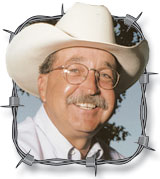If you like old cowboy stories, here’s one you’re bound to love.
“It was the spring of 1927, and all I had to look forward to was a long, hot summer in western Oklahoma. I saddled up my black mare, Peggy, and headed west…”
The speaker’s name was Lyle Edgar. I met him many years ago at the Greene County Court House, where he had finished off his working life as a bailiff for a judge.
It was true exploits as a real cowboy that he wanted to tell about. His first words sounded like a boy’s fiction story, what any red-blooded American boy would do in his dreams.
But it was true adventure for Lyle Edgar, and he remembered it vividly:
“I was only 16 years old,” he said. “My mother was dead and my father didn’t mind too much that I wanted to see the country. I tied a couple of blankets behind my saddle and panhandled my way.
“In those days, it was the trick to ride up to a farm house or ranch at meal time and ask if you could feed and water your horse. The farmer or rancher would always invite you to eat and often to stay overnight.
“At that time, even U.S. 66 was a dirt road, and sometimes I would just cut across the country, opening a ranch gate when I came to a fence and riding through the ranch to a gate on the other side. The country was mostly open then, and there were rivers to cross without bridges. I came to the Washita River, for instance, and had to swim my mare across.
“I got out of the saddle and held onto her tail and we got across fine. All went well, except that as my new boots began to dry, they shrank. It was four days before I could get them off.”
By the time he got to Tucumcari, N.M., Edgar began to think about a job. He learned that the Bell Ranch west of town might be hiring. A telephone call landed him the job.
The Bell Ranch had one of the most fabulous histories of the Old West. It had its beginning in the mind of one Don Pablo Montoya, a captain in the army of the king of Spain.
“I worked around there for a week, making a couple trips to Tucumcari for supplies with a four-line team. There were 25 to 30 men around headquarters all the time, and fencing and windmill crews were out the year around.
“I learned there was a remuda of some 400 head, and that the roundup crew, which went out in the spring and didn’t return to headquarters until after fall branding, consisted of the wagon boss, top hand, two horse jinglers, the cook and a helper and 35 cowhands.
“The wagon boss that year was Mark Woods and the top hand Ralph Bond. They assigned me to the wagon and I took out a load of supplies the 20 or 30 miles from headquarters and Mark Woods cut me out a string of horses.
“The first one he cut out was called Little Brown Mouse and he was inclined to buck, but he was an easy bucker so I was able to put on a pretty good show with him the first day and became accepted by the men. Riding was no chore for me. My father, Robert J. Edgar, was a farmer and rancher, and I started to ride at such an early age I cannot remember it. Riding horses was just a part of my life.
“The first day’s drive began, as always, before daylight. We rode over several sections and gathered everything we could find.
“There were no corrals. Usually the top hand and wagon boss did the calf roping while half a dozen hands held the herd. The two ropers could keep six or seven sets of flankers busy, and the whole operation didn’t take over 20 or 30 seconds per calf.
“A morning’s drive would net about 1,500 head, with 600 or 700 calves being worked in the afternoon. Following the branding teams by several days was a crew of cowboys who checked calves for screw worms. There was lots of trouble with worms in those days. They were treated with a homemade concoction of sulfur and chloroform to kill worms.
“The wagon pulled into headquarters a few days before Christmas and it was customary for the last cowboys hired to be laid off for the winter, since ranch work was slow. I went to Rosebud, N.M., and teamed up with a bunch hired to drive a herd of steers to Texline, Texas.
“Because it was the dead of winter, they paid fabulous wages – $2.50 a day. The drives had to be made in winter because there was no water on the way and cattle could go that long in winter, but not in summer.
“We made two of these drives that winter, and when I finished I picked up my mare from Bell Ranch and rode.
"I wound up at the Diamond A Ranch in Roswell, N.M., that fall, and helped dip cattle until Thanksgiving, and then went into service at Fort Reno.
“I broke polo ponies and remounts for a long time. After 27 years in the service I retired. I worked for Hughes aircraft in California until I moved to Greene County, where I raised our Quarter Horses and worked at the court house.
“Of all my life’s work, I would say the life on the ranch was the greatest. There was no hardship or misery involved, and I was doing what I really loved to do.”
Lyle Edgar told me that story 27 years ago. I haven’t seen him for almost that long and have lost track of him. I’d like him to know “it was a pleasure,” and his cowboy story will always remain one of my favorites.
I hope you enjoyed it, too.






